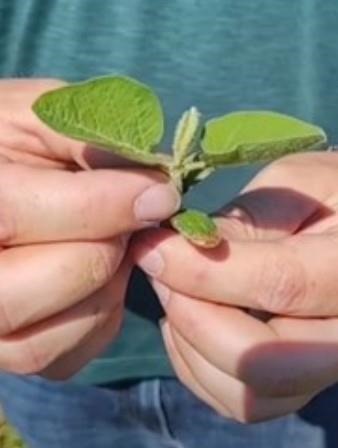By Laura Lindsey
Cool, wet weather in April and early May delayed soybean planting progress; however, with some warmer and drier days, soybean planting was 18% complete by the second week of May (Table 1). Soybeans that were planted the end of April or first week of May are likely at the VC growth stage or will be at the VC growth stage soon (Figure 1).
Table 1. Percent soybean acres planted in Ohio by week for the past five years (USDA NASS).
Week | 2022 | 2021 | 2020 | 2019 | 2018 |
2nd Week of April | 0% | 1% | 0% | 0% | 0% |
3rd Week of April | 0% | 8% | 0% | 0% | 0% |
4th Week of April | 2% | 17% | 2% | 1% | 1% |
1st Week of May | 4% | 20% | 7% | 1% | 8% |
2nd Week of May | 18% | 29% | 24% | 2% | 31% |
What does the soybean crop need to maximize yield during vegetative growth? During vegetative growth, green plants use the energy in sunlight to power photosynthesis. This process uses water, carbon dioxide from the air and light energy to produce sugars. Sugars are then converted into plant dry matter. Chlorophyll in green leaves, stems and pods gathers light for photosynthesis. During vegetative growth, plant dry matter distributed to leaves, stems and roots enables the plant to “build the factory” for producing seed later in the season.

Figure 1. Soybean at the VC growth stage (unifoliolate leaves unrolled sufficiently so the leaf edges are not touching)
The amount and distribution of leaf area together make up the canopy, and canopy cover increases as leaf area increases. Leaf area is measured as the leaf area index (LAI) or the acres of leaf area per acre of crop. Because leaves aren’t uniformly distributed, and because some light passes through a leaf without being intercepted, LAI may need to reach 5 or 6 before the crop intercepts nearly all of the sunlight. Light interception, canopy photosynthesis, and crop growth rates increase as the canopy develops, with light interception increasing from less than 1% of the amount of sunlight that falls on an acre as plants emerge, to nearly 100% during pod filling. An early start and rapid pace of canopy development means more rapid increases in crop growth rate, which sets the stage for higher yields.
Misconceptions at the VC-V3 growth stage: There are several common misconceptions about soybean plants at the VC to V3 growth stage.
Misconception | Reality |
Very early planting often means that cool temperatures limit early growth, but plants can still grow their root system even if leaves don’t grow very much. | Once the reserves in the cotyledons are used up, growth requires light interception by leaves and air temperatures above 55-60°F; without this, no part of the plant will show much growth. |
Leaf area needs to develop rapidly from the beginning, and all of the leaf area the plant develops needs to stay healthy for yields to be high. | Vegetative development takes place over more than half of the soybean growing season, so leaf area lost early can often be recovered as growth continues with no loss in yield. |
Leaves should be dark green, and any pale green or other off-colors that appear in young plants signal yield losses to come. Tissue sampling can detect specific nutrient deficiencies, and these should be corrected as soon as possible. | Low temperatures and cold soils alone can cause poor leaf color. Small plants have small root systems and acquire nutrients slowly, with few exceptions (i.e., iron chlorosis, caused by high pH). Poor plant color usually corrects quickly once temperatures increase with no loss in yield. |
Source : osu.edu